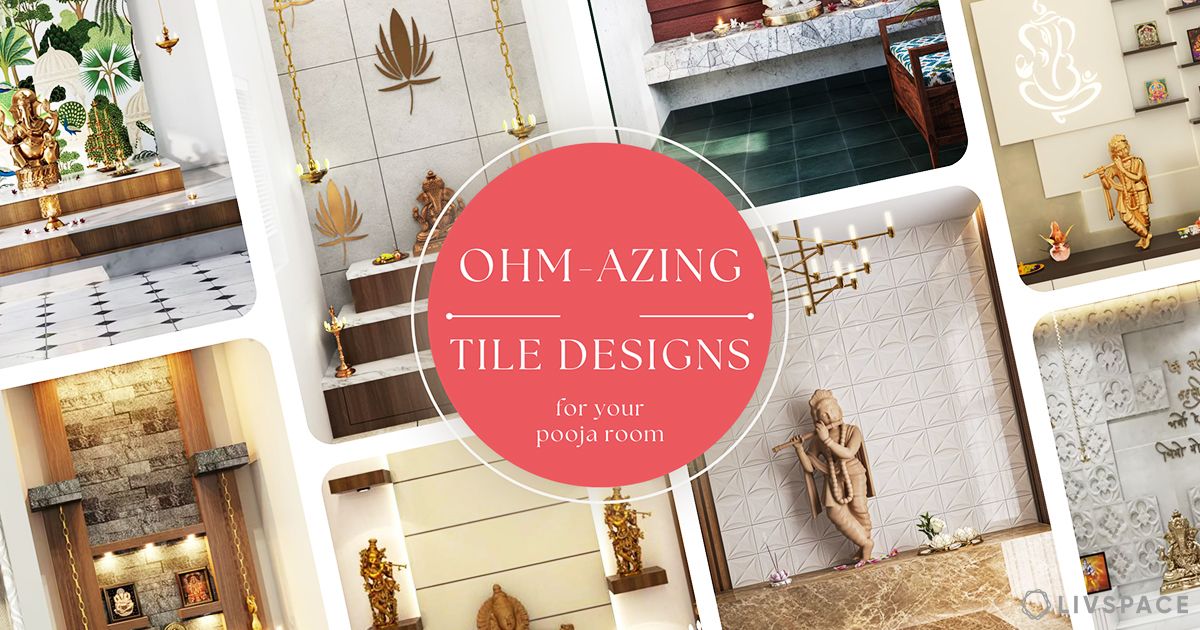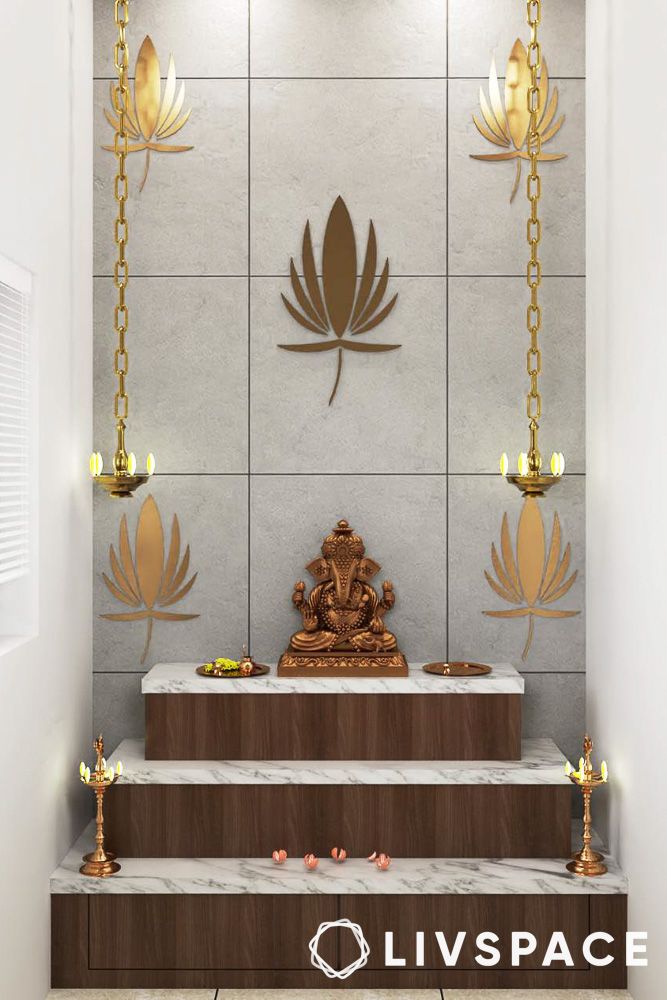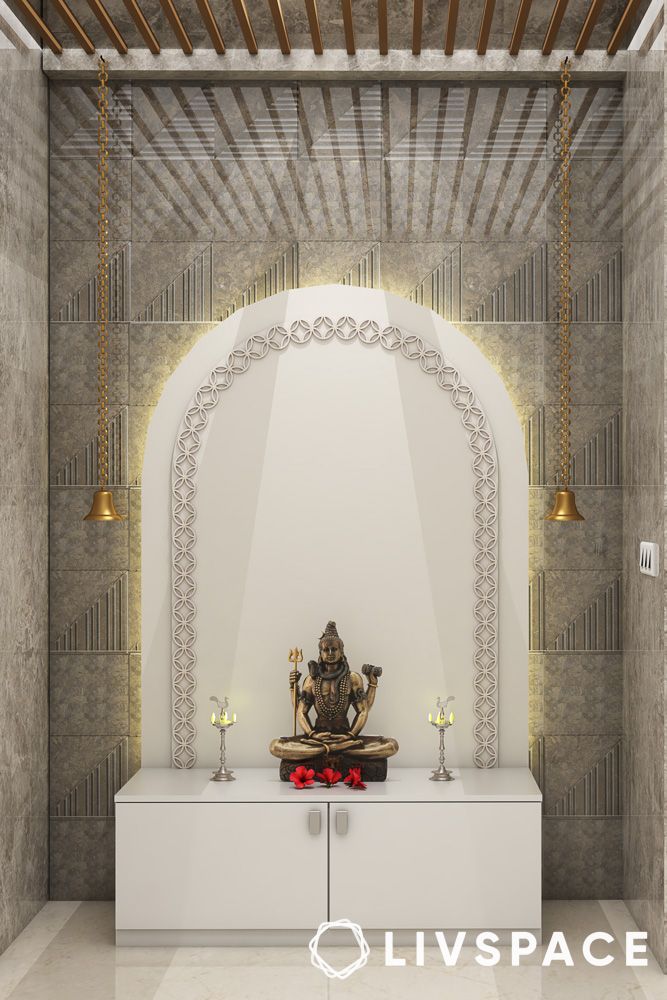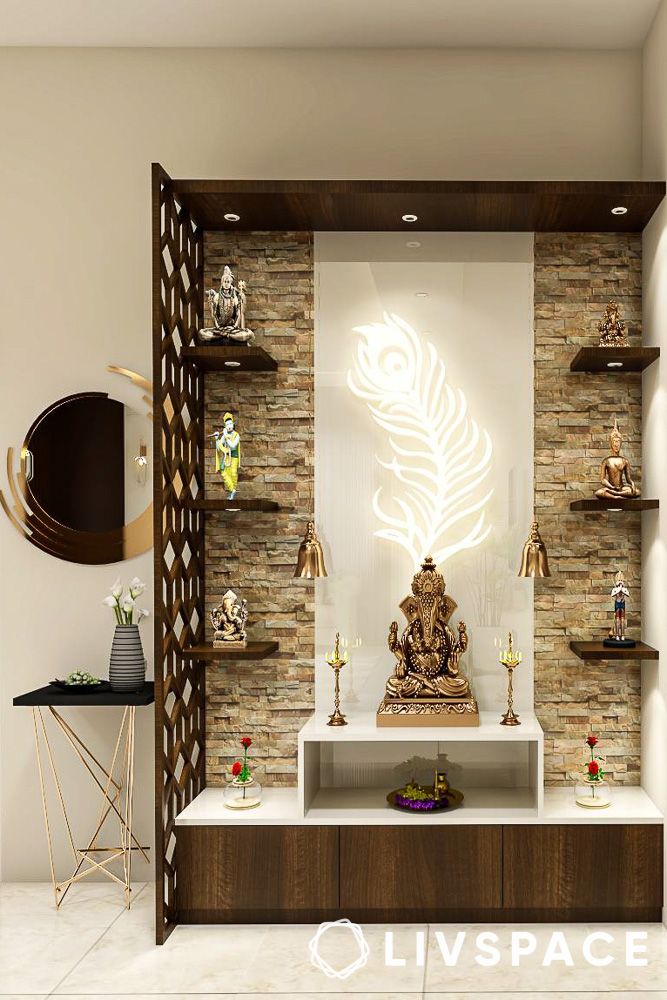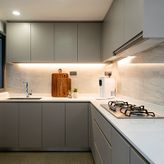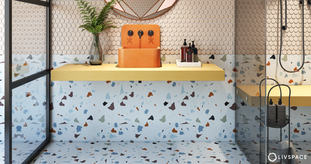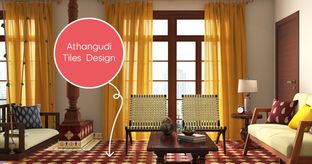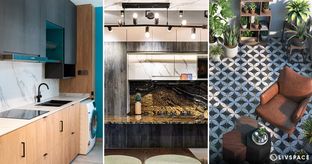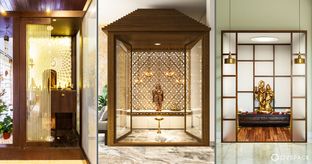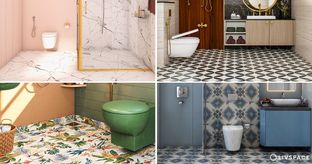In This Article
- Colour psychology and its impact on the choice of tiles
- Cost of tiles according to material
- Tile finish (matte, glossy, textured)
- #1: Glossy marble tile designs for pooja room
- #2: Concrete tile designs for pooja room
- #3: Modern pooja room tiles design with Kota stone
- #4: 3D tiles for pooja room
- #5: Wooden mandir tiles design
- #6: Modern pooja room square tiles design
- #7: Ceramic tiles design for mandir
- #8: Layered tiles design in pooja room
- #9: Vitrified tiles design for mandir
- #10: Modern pooja room tiles design with porcelain
- #11: Mosaic tiles design for a pooja room
- #12: Modern pooja room tiles design with granite
- Impact of tile size on the pooja room
- Protecting tiles from stains and scratches: Maintenance tips
- How to choose a tile sealer?
- How can Livspace help you?
Designing a special spot in your home for prayer and meditation is a deep personal journey. Tiles can really make or break that vibe. Let’s a take look at some pooja room tile designs, its maintenance tips and how you can choose the perfect tile.
Colour psychology and its impact on the choice of tiles
Colours evoke specific emotions and energies, making them a crucial part of tile selection. Here’s what you need to keep in mind:
- Select colours that resonate with your beliefs and faith
- Consider the pooja room’s natural lighting and how it will affect the colour scheme you chose
- Always balance neutral accents with bold colours to not overwhelm the scheme
But how do different colours affect the spiritual atmosphere?
- Light blue signifies spiritual connection and calmness
- Cream or white signifies peace
- Red is the colour for divinity (in Hinduism)
- Orange represents fire and thereby purity
- Yellow (the colour of Lord Vishnu) is associated with purity and victory (some tribes believe yellow keeps the evil spirits away)
- Brown represents natural connection, stability, and grounding
- Gold is believed to purify anything that it touches
Also Read: Top 5 Colours That Will Bring Good Vastu Vibes to Your Pooja Room
Cost of tiles according to material
| Tile material | Cost of tile per sq. ft. (without installation charges)* |
| Vinyl | ₹70 |
| Vitrified | ₹120 |
| Granite | ₹200 |
| Marble | ₹150 |
| Porcelain | ₹65 |
| Ceramic | ₹60 |
| Natural stone (Kota stone) | ₹250 |
| Hardwood | ₹770 |
| Laminate wood | ₹285 |
| Concrete | ₹90 |
| Onyx | ₹300 |
| Mosaic | ₹150 – ₹400 |
Tile finish (matte, glossy, textured)
The finish of a tile significantly impacts its appearance and functionality. Here are some common types:
Basic finishes
- Glossy: Offers a shiny, reflective surface to create a modern, luxurious look
- Matte: A non-reflective finish that provides a soft, subdued appearance, perfect for creating a minimalist or rustic look
- Satin: A blend of glossy and matte, offering a subtle sheen
Textured finishes
- Polished: Creates a smooth, mirror-like finish. Ideal for showcasing the natural beauty of stone tiles
- Honed: A matte finish created by grinding the tile surface, offering a soft, velvety feel
- Rustic: Features uneven surfaces and natural imperfections for a raw, earthy look
- Textured: Offers a variety of textures, from embossed patterns to 3D designs
Other finishes
- Metallic: Provides a shimmering, metallic look with options like gold, silver, or copper
- Glazed: Adds a protective layer and can create a variety of colours and patterns
- Unglazed: Exposes the natural material of the tile, often used for porcelain or ceramic tiles
#1: Glossy marble tile designs for pooja room
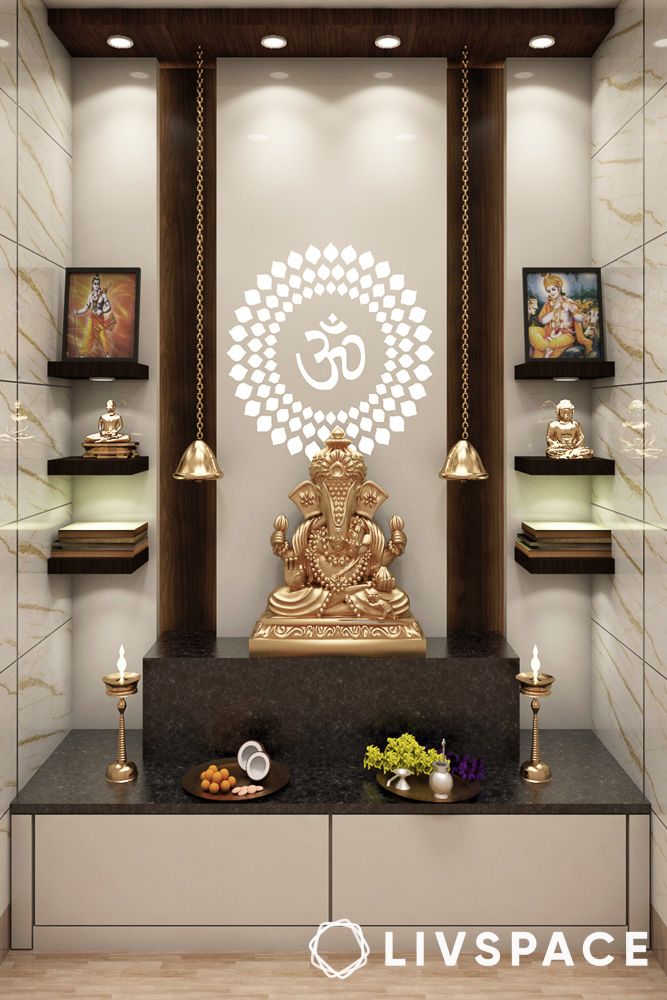
You might be wondering if polished and glossy marble are the same: post-processing marble with a “polished” finish preserves its natural, light, and opaque colour, while the “glossy” finish emphasises vein contrasts and creates a shiny surface. See how it reflects the diya lights? It adds to the divine ambience of the pooja room.
Also Read: Italian Marble vs Indian Marble: Cost, Benefits, Durability to Determine the Best Choice
#2: Concrete tile designs for pooja room
All concrete/cement designs in home interiors equal minimalism and industrial charm. Choose simple types of tiles if you want your diety and other design elements to be in focus. Here’s what you can do:
- Opt for plain, unadorned concrete tiles in neutral shades like grey or off-white to create a clean and modern look
- Choose concrete tiles with subtle textures like exposed aggregate or stamped patterns to add depth and interest
- You can also incorporate pops of colour through accents like wooden frames, metal inlays, or colourful artwork to balance the coolness of concrete
#3: Modern pooja room tiles design with Kota stone
Natural stone tiling on the wall is called stone wall cladding and it adds a touch of luxury to your pooja room. Pair them with simple wooden or metal puja furniture to create a modern, minimal look. Use rough-cut Kota stone tiles for a rustic and traditional feel. Complement this with wooden accents, brass or copper puja items, and earthy colour palettes.
#4: 3D tiles for pooja room
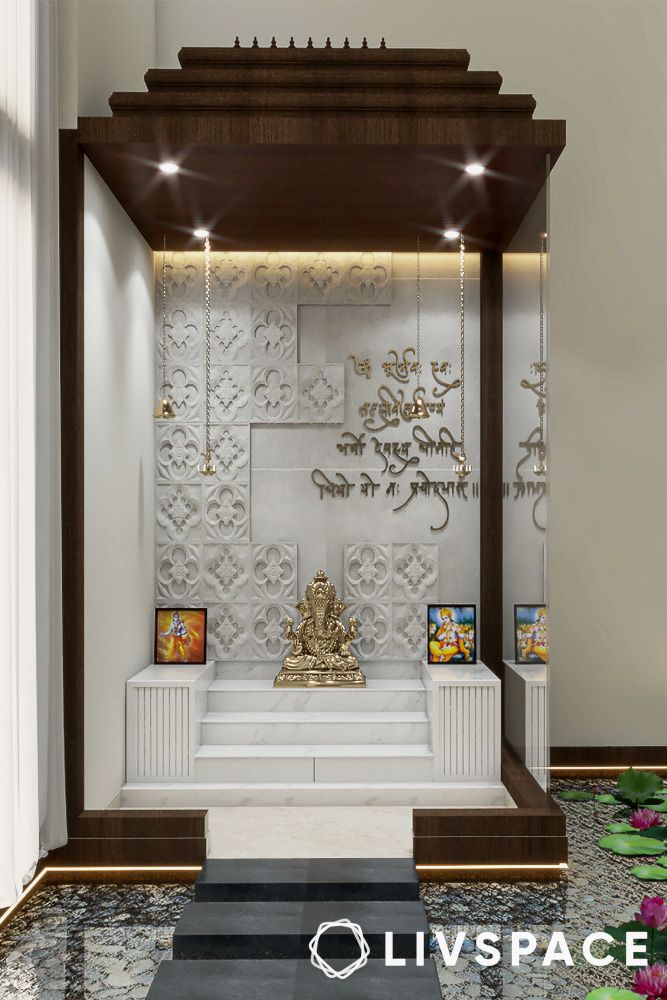
You can find them in subtle textures, geometric patterns, or even floral motifs. They’ll totally upgrade your pooja room, whether you’re going for a modern or classic look. But, you got to make sure to light them right to show off their 3D magic. One thing to keep in mind is that they might be a bit trickier to clean because of all the bumps and curves. To make it even cooler, mix and match them with wood or glass tiles for a stylish combo.
#5: Wooden mandir tiles design
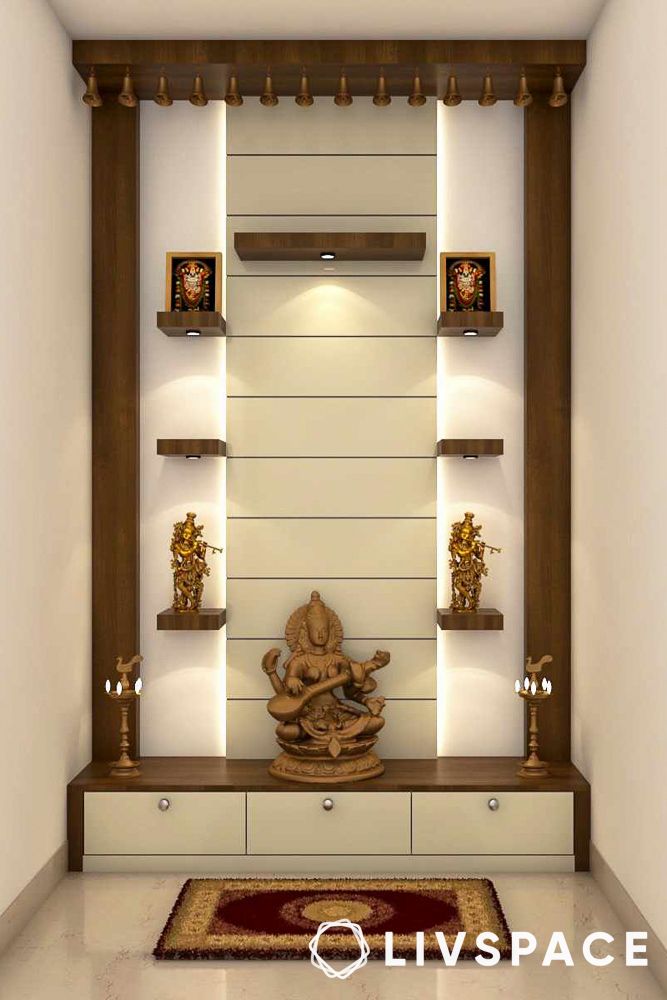
Wooden tiles come in various finishes, from rustic to modern, allowing for customisation to suit different styles. They are resistant to moisture and scratches, making them a practical choice for high-traffic areas. Wood also has sound-absorbing properties, contributing to a quieter and more peaceful environment.
#6: Modern pooja room square tiles design
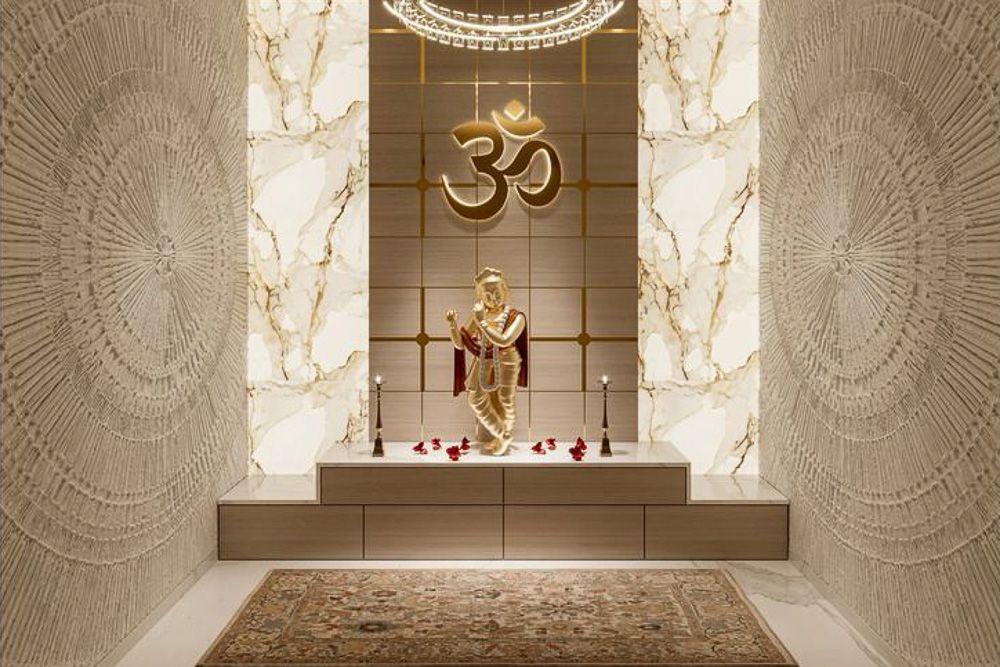
Image credits: Pinterest @deepkuldeep167
The simplicity of square tiles creates a sense of order by providing a balanced and visually pleasing appearance. They can be combined with other design elements like borders, mosaics, or wall art to create visual interest. You can mix square tiles with rectangular or hexagonal tiles for a dynamic look.
#7: Ceramic tiles design for mandir
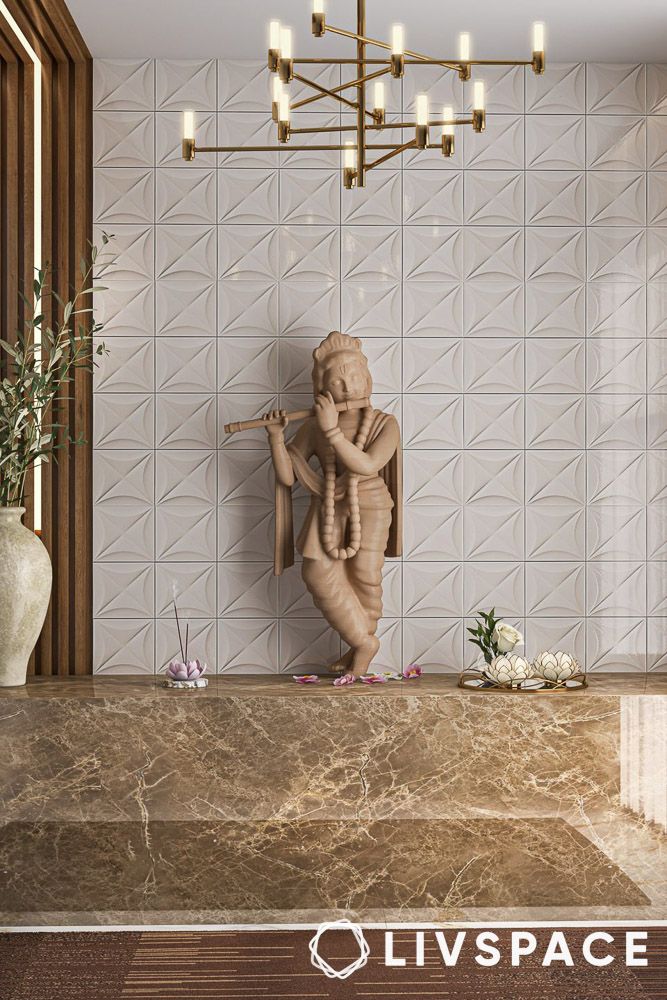
Ceramic tiles are known for their durability, resisting scratches, stains, and moisture. They come in an extensive range of colours, patterns, and textures, allowing for customization to match any pooja room style. On top of that they are quite budget-friendly compared to other types of tiles.
#8: Layered tiles design in pooja room
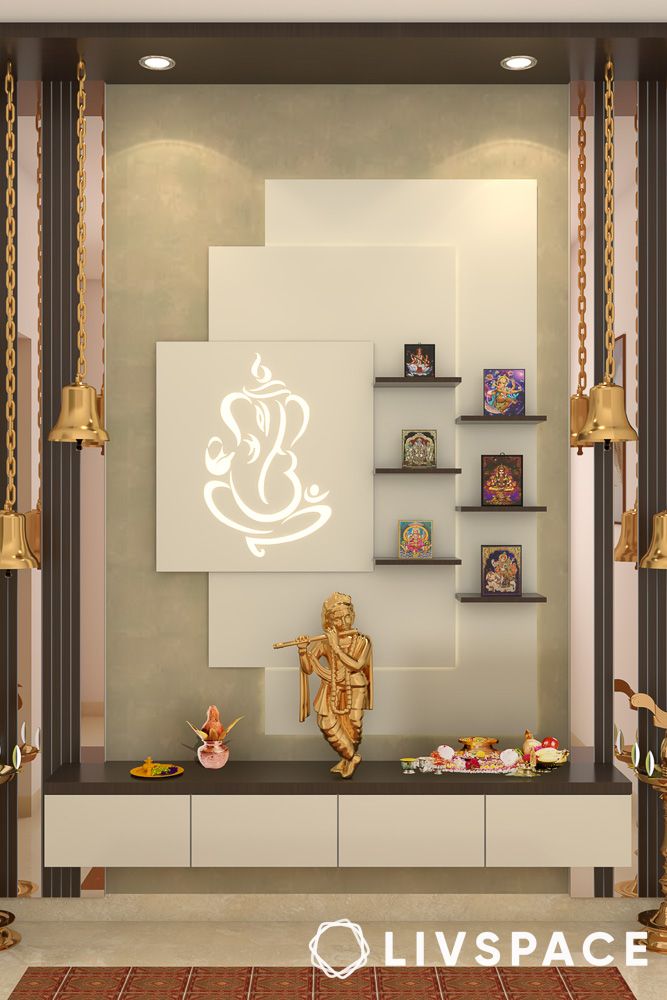
Layering different tiles creates depth and dimension, making the space more engaging by creating a focal point. Note that layering tiles with contrasting colours or textures can create a striking visual impact, while complementary tiles can foster a harmonious atmosphere.
#9: Vitrified tiles design for mandir
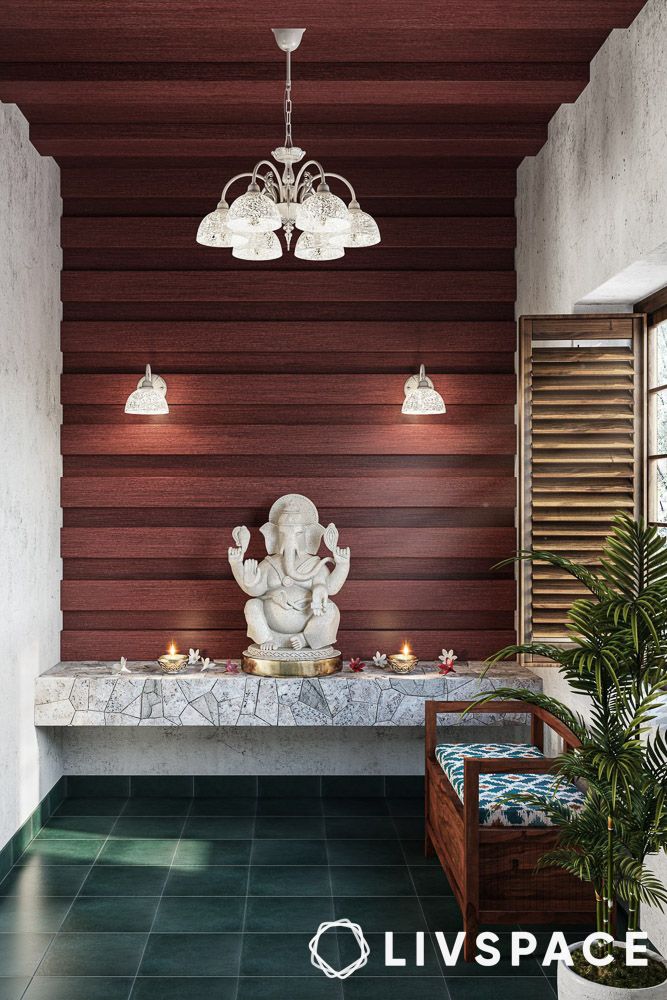
Known for their strength and resistance to scratches, stains, and water, vitrified tiles ensure the pooja room maintains its pristine look for years. Their non-porous nature makes cleaning easy, ensuring the sacred space remains hygienic. Moreover, many vitrified tiles come with a glossy finish that reflects light, creating a sense of spaciousness.
#10: Modern pooja room tiles design with porcelain
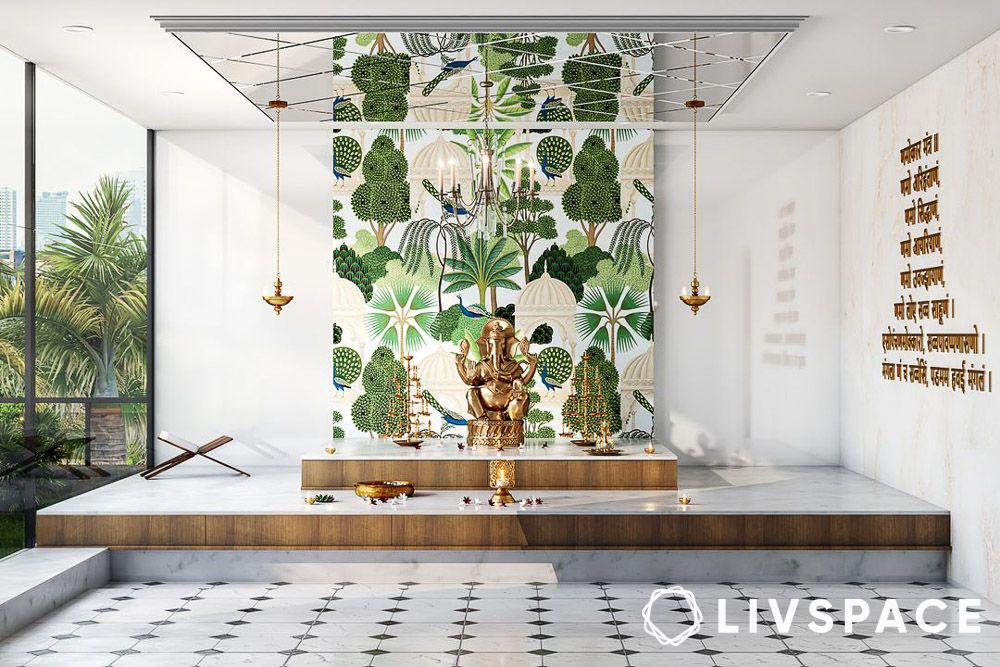
Porcelain tiles are fired at higher temperatures, making them denser and more resistant to scratches, stains, and wear and tear. This durability is essential for high-traffic floors like a pooja room.
#11: Mosaic tiles design for a pooja room
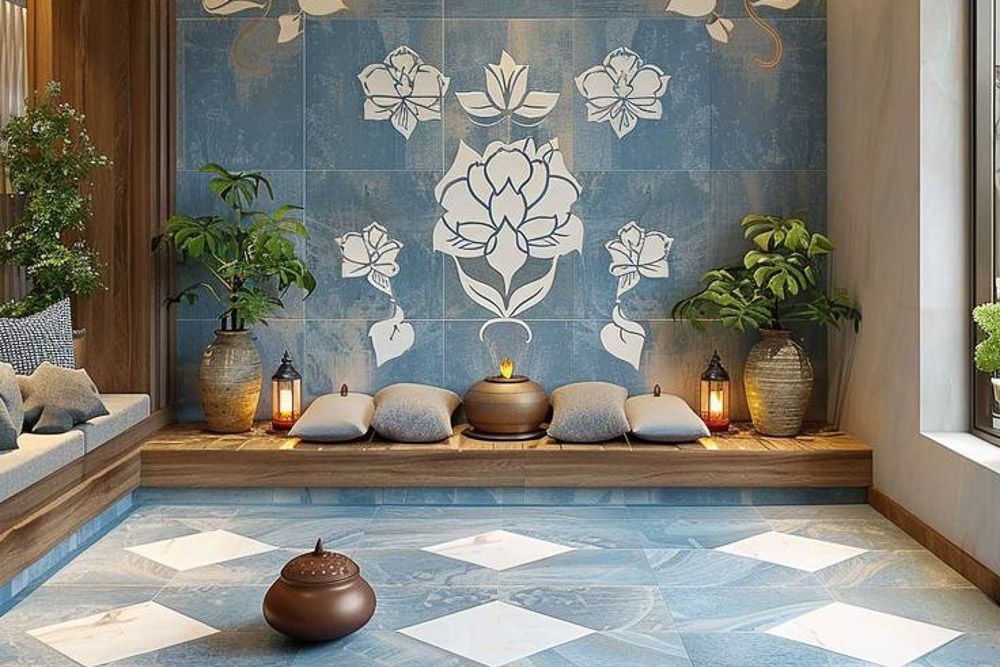
Image credits: Pinterest @ArtFacade
Mosaic tiles are like little pieces of art that come together to create something amazing! They add a cool, 3D look to any space. Go for glass mosaic tiles if you want a luxurious touch to your pooja room. You can totally customize them with your favourite colours, designs, or even lucky symbols!
#12: Modern pooja room tiles design with granite
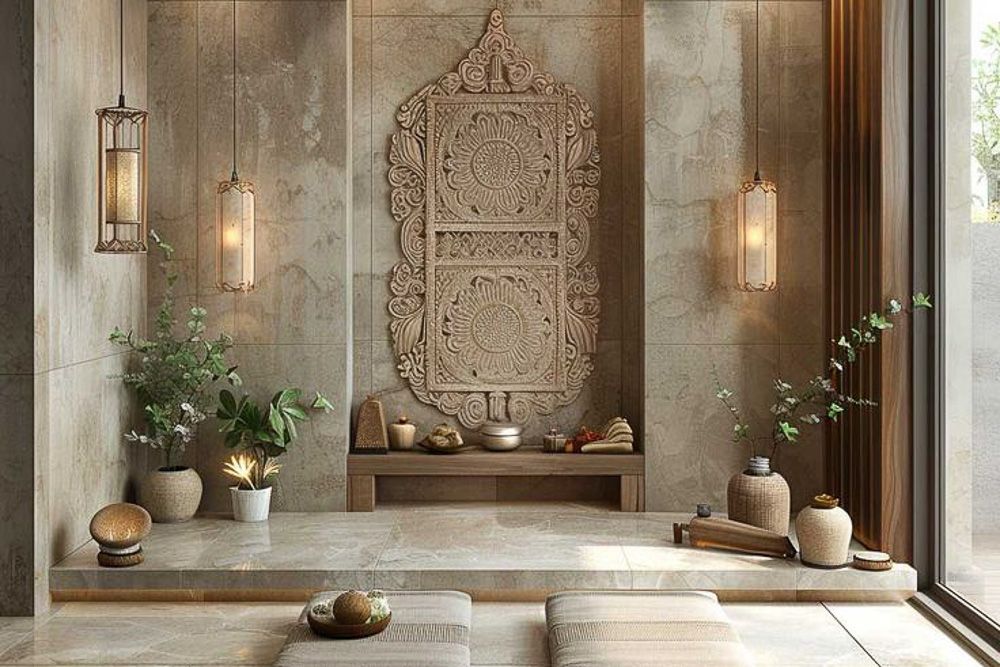
Granite is a natural stone with a hard, dense structure. This makes it challenging to carve or etch intricate patterns into it. Most designs on granite tiles are achieved through natural variations in the stone’s colour and pattern, rather than intentional carving.
You can put up a CNC cut panel that matches the granite’s colour for the intricate designs. If you’re looking for intricate designs for your pooja room, consider these alternatives:
- Granite with natural veining: Choose a granite with a distinctive and intricate vein pattern to create a natural, artistic look
- Mosaic tiles: Combine small granite tiles with other materials like glass or ceramic to create intricate designs and patterns
- Stencils: Use stencils to paint intricate designs on granite tiles for a more affordable and customisable option
- Digital printing: Some tile manufacturers offer digital printing on granite tiles, allowing for a wider range of design possibilities
Impact of tile size on the pooja room
The size of tiles can significantly influence the overall look and feel of your pooja room. Here’s how:
Smaller tiles
- Intricate designs: Smaller tiles allow for more intricate patterns and designs, creating a visually interesting floor or wall
- Visual interest: They can make a small space appear larger due to the number of grout lines.
Larger tiles
- Spaciousness: Larger tiles create a sense of openness and can make a room appear more spacious
- Minimalist look: They offer a clean and modern aesthetic
- Fewer grout lines: Less grout means less cleaning and maintenance
Other considerations
- Room size: The size of your pooja room will influence the appropriate tile size
- Tile shape: Square, rectangular, or hexagonal tiles can create different visual effects
- Grout colour: The colour of the grout can significantly impact the overall look. A lighter grout colour can make the room appear larger, while a darker grout can create a more defined look
Protecting tiles from stains and scratches: Maintenance tips
- Concrete tiles can be porous, so regular sealing is essential to protect against stains and water damage (re-apply the sealant every 1-2 years or as needed)
- Avoid harsh chemicals or abrasive cleaners that can damage the tile’s finish
- Ensure proper ventilation in the pooja room to prevent moisture buildup
- Clean regularly using mild detergent and water but make sure there are no wet spots left after the cleaning
How to choose a tile sealer?
Selecting the appropriate sealant for your tiles is crucial to protect them from stains, moisture, and wear and tear. Here’s a breakdown:
Types of sealants
- Penetrating sealers: These soak into the tile, protecting it from within. Ideal for porous tiles like natural stone
- Surface sealers: These form a protective film on the tile surface. Suitable for less porous tiles like glazed ceramic and porcelain
Factors to consider
- Tile type: Different tiles have varying porosity. Porous tiles (like natural stone and unglazed ceramic) require penetrating sealers, while glazed tiles might benefit from surface sealers
- Location: Indoor tiles have different needs than outdoor tiles, which face harsh weather conditions
- Traffic: High-traffic areas might require a stronger sealant
Application tips
- Clean thoroughly: Ensure the tile surface is clean and dry before applying the sealant
- Follow instructions: Adhere to the manufacturer’s recommendations for application, drying time, and reapplication
- Test in an inconspicuous area: Test the sealant on a small, hidden area to check for any unwanted changes in appearance
How can Livspace help you?
Livspace offers a comprehensive approach to interior design, including expert guidance on material selection.
- Visit your nearest experience centre to take a look at our extensive collection tiles
- Our team of interior designers will help you with 3D renderings to visualise your pooja room design
- You can avail the flat 10-year warranty* on select products
Let us help you create your dream home interiors along with the best materials! Book a consultation NOW!
*For select finishes on modular products. For full scope of warranty, please visit livspace.com/in/service
Disclaimer: All contents of the story are specific to the time of publication. Mentions of costs, budget, materials, finishes, and products from the Livspace catalogue can vary with reference to current rates. Talk to our designer for more details on pricing and availability. The Pinterest images used in this blog are solely for illustrative purposes. We do not claim ownership of these images, and all rights belong to their respective owners. If you are the owner of any image and would like it to be removed or credited differently, please contact us.

